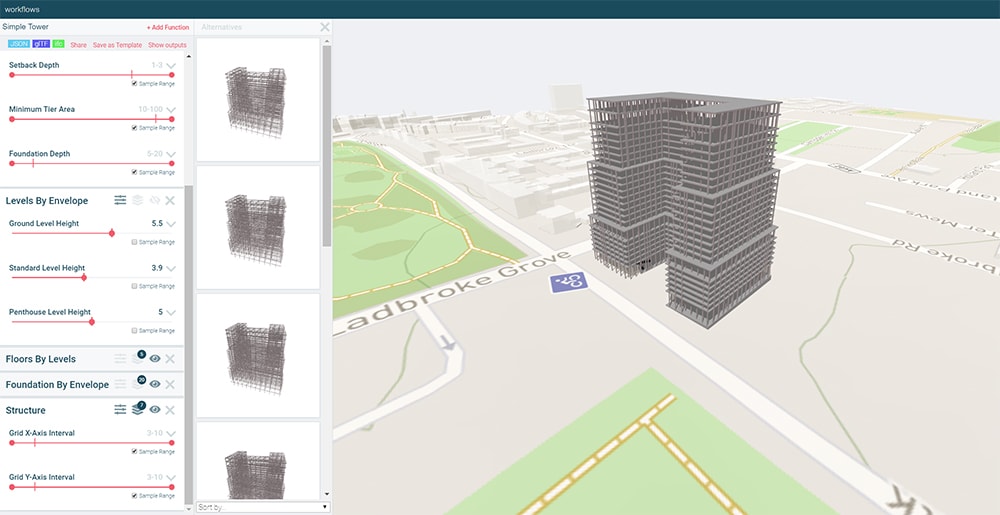More than 2,000 users have signed up to a generative design platform that its developers claim could revolutionise knowledge sharing in construction.
Hypar is a cloud platform created by industry veterans Anthony Hauck, former head of Revit product development at Autodesk, and Ian Keough, the so-called “father” of visual programming interface Dynamo.
The tool is based on open data standards and enables users to create and upload different generative “functions” – essentially modules of building expertise – that quickly produce multiple options for specific problems. Functions from different users, or other third parties, can be combined to tackle more complex problems and develop a more rich and refined design.
Of the 2000+ users worldwide, most are based in North America, Northern Europe and Nordic countries. According to a quote on the website, in the UK Jacobs has identified the platform as a key component in its automated design strategy.
Hypar was created to put specialist design tools, normally only available via professional consultants, into the hands of any building professional to enable them to plan and interrogate the feasibility of new projects.
Hauck told BIM+: “We believe there is a possibility for building expertise to be recorded in ‘functions’ covering things like: how to lay out a building envelope; how to populate it with a structure; and how to populate it with slabs. These are things that building professionals often know, but still rely on professional consulting to deliver. If every time you want to use a piece of software you have to call a consultant to run it for you that is an inherently unscalable model.”

An example of Hypar workflow with structural options
In one potential use case, a design for a high rise tower is optioneered based on a combination of six different functions. One function helps users pick a location, one draws the building footprint within the location, a third turns the footprint into a building envelope, and subsequent functions will populate the envelope with levels and a structure.
Hypar is ultimately intended to become a comprehensive repository of building expertise that can help rapidly scale up the distribution and sharing of knowledge across the sector.
“Even though we have a history of 5000 years of recorded architecture, and reams of documentation on how we should construct buildings, including building codes, best practice or Architectural Graphic Standards, most projects still start from a blank page,” said Hauck. “Hypar delivers expertise from multiple organisations to help users quickly create great designs.”
Even though we have a history of 5000 years of recorded architecture, and reams of documentation on how we should construct buildings, including building codes, best practice or Architectural Graphic Standards, most projects still start from a blank page.– Anthony Hauck
Hypar is accessible via any internet-enabled device and generative functions are created, manipulated and combined via a common user interface. However, users who want to create their own functions will require basic knowledge of code in the form of Python and C#. The open data model supports the IFC file format making it possible to export some workflows to BIM software, including Revit.
Hypar’s team also works with users to help them create functions to ensure they work within the UI, have an accurate interactive 3D representation and to ensure compatibility with other functions. Hauck compares the process to the inception of Apple’s App Store, when the company helped seed the store with applications before it became successful.
In one example, Hypar worked with a contractor to help it develop a function that would take IFC data on walls within a building and turn it into a function for a concrete pour “diagram”. Hauck said: “We divided the walls up according to a series of pour rules, with variations related to things like the level of tolerance and how corners go together etc. Then the user would get 20 options for how to achieve it. The output could be downloaded as an IFC for Revit, Tekla or other software.”
Access to everything on Hypar is currently free, but the tool will eventually transition to a subscription-based model similar to that of Amazon Prime, says Hauck. Subscribers will pay a basic price to access to all the basic content and pay an upcharge for premium content.
To encourage uptake and expand the repository, reduced rates will be offered to contributors that upload functions and make them available to all Hypar subscribers.
Could the platform one day spell the end of professional consultants? Hauck says no: “We definitely don’t see this as a replacement for consulting, we’re really hoping to augment the professions whilst distributing their expertise to a wider audience that otherwise wouldn’t be able to access professional consultation.”











